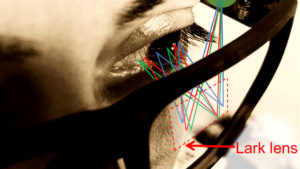Lark Optics is a Cambridge-based startup that has developed a way to address the issue of AR sickness. The company has created AR glasses that project images directly onto the user’s retina, eliminating the depth mismatch that causes discomfort and physical symptoms. The company aims to sell the components they design to original equipment manufacturers that create AR headsets.

According to CEO Pawan Shrestha, Lark Optics’ approach is more efficient in terms of processing and battery power and does not affect the user’s field of vision. Other companies are addressing the issue of AR sickness using different methods, but Shrestha believes that Lark Optics’ approach is the best. The startup raised a pre-seed round of £210,000 ($255,000) in October 2022 and plans to raise a seed round in Q2 2023. The company aims to become established as the best optics for AR, VR, and mixed reality glasses.
What Do We Think?
One of the main challenges in AR is vergence, the shifting of focus form the display surface to the real world and vice versa. But what if you didn’t have to make the adjustment? If the AR display was impinged on your retina it would be visible as an overlay of the real word and multiplane focus issues would disappear. You would see things like the terminator.
Lark Optics thinks that can accomplished by projecting the AR image directly to your retina and eliminating an intermediate focal plane. They will use a pair of glasses as a reflector to direct the image form a LCOS or microLED display through a lens in the glasses that will focus on your retina in what they are referring to as a nano-optical solution..
It’s a great idea with a key problems in making it work. Finding the correct focal point from the glasses’ lens to your retina will not be the same as finding it to my retina. Nor will the glasses with the reflecting lens stay in the same place as we move about.
However, an eye-tracking feedback micro-servo system that uses an interferometric system to find your retina and then adjusts the emitter’s position to compensate, could work. Such system could compensate for the glasses movement and the physiological differences between wearers.
As it turns out, one of the founders’ CEO Pawan Shrestha’s early work was in interferometry. The company hasn’t disclosed how they will deal with variable focus issue, but if they can overcome it, a retina based system will indeed solve one of the major barriers to wide acceptance of AR. But Lark Optics is not the first to think of this.
In 2008, Brothers Industries introduced their Retina Impinging AR glasses, a pioneering imaging display system. The technology behind the glasses was based on projecting light at a safe intensity onto the user’s retina. By moving the light quickly, afterimages were formed, giving users the impression of looking at a 16-square-inch screen from a distance of one meter. Brothers Industries utilized their expertise in optical system technologies from laser printing and piezoelectric technologies from ink-jet printing to develop the system. The AR glasses aimed to provide users the ability to read documents such as operation manuals in confined spaces or facilitate hands-free operation when both hands were needed for other tasks.
Retinal Imaging

In 2008, Brother successfully created a wearable Retinal Imaging Display (RID) prototype resembling spectacles. This lightweight prototype weighed 350 grams and offered an SVGA resolution (800×600) at a 60 Hz frame rate. NEC was the source of the technology used in the prototype.

On July 21, 2010, Brother announced the AiRScouter, an evolution of their RID prototype. The AiRScouter was showcased at Brother World JAPAN 2010 in Tokyo on September 15th. Following additional refinements, Brother revealed the commercialization of the AiRScouter on August 24, 2011.
On October 17, 2011, NEC introduced the Tele Scouter in Japan, a device developed based on the AiRScouter technology. The Tele Scouter featured an updated design and improved functionality. The device was aimed at professional applications, such as providing real-time information and guidance to field technicians. NEC continued to offer a variation of the system until at least 2015. In recent years, there has been limited information about the Tele Scouter or related technologies, suggesting that either the focus has shifted to other developments or that further improvements are being made behind the scenes.
The introduction of Retina Impinging AR glasses and subsequent devices, such as the AiRScouter and Tele Scouter, marked an important milestone in the history of AR technology. These devices demonstrated the potential of AR applications in various industries and laid the groundwork for future advancements in the field.
I have recently updated my book, Augmented Reality: Where we all Will Live (2nd edition), which has a lot more information and historical perspective if you are, as I am, interested and curious about the path AR technology is weaving through the industry.

